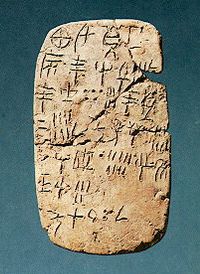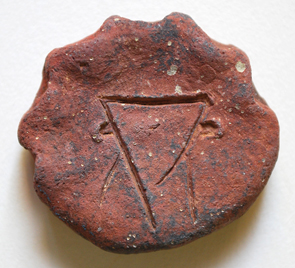Examples of writing
Tablet HT 13 (Crete, Agia Triada, mid-15th century BC)

Source:
http://www.historywiz.com/myc-civ.htm
Trasnumeration (the numbers are in bold)
.1-2 AB 77-09-45-59 AB 04 • AB 131
.2 AB 27-17 5[ ] A 707[ ]
.3 AB 04-69 56
.3-4 AB 04-67 27 A 707
.4 AB 81-79-30 18
.5 AB 01-41-A 118 19
.5-6 AB 28-51-24-41 5
.7 AB 81-02 130 A 707
Conventional transliteration based on homomorphic logograms and syllabograms of Linear B (the fraction sign A 707 is conventionally transliterated with J).
.1-2 ka-u-de-ta VIN • TE •
.2 re-za 5[ ] J[ ]
.3 te-tu 56
.3-4 te-ki 27 J
.4 ku-*79-ni 18
.5 da-si-*118 19
.5-6 i-du-ne-si 5
.7 ku-ro 130 J
The tablet records quantities of wine. The logogram VIN is preceded by the syllabic sequence ka-u-de-ta and followed by the “transaction sign” TE. On lines 2-6 variable quantities of goods are registered, each preceded by a syllabic sequence. On line 7 a very large amount is registered (130+J), preceded by the syllabic sequence ku-ro. Since 5+56+27+18+19+5 = 130, ku-rois evidently the word for “total”. As other texts indicate, the fraction J corresponds almost certainly to ½. The total should therefore be 130+ ½ + ½ , i.e., 131 units. Consequently, it is possible that the scribe made a mistake while summing up the single quantities. It is difficult to say if the syllabic sequences were anthroponyms or toponyms and what their relationship to the wine was (suppliers or recipients).
Roundel KH Wc 2122 (Crete, Chania, 15th century BC)

Trasnumeration
A 408vas
The roundels are clay disks with one ore more seal impressions on the rim (six in the case of the roundel in the photo). The most probable hypothesis is that the roundels were “receipts” given by those who took goods from the warehouses of the palaces. The persons removing the goods were identified by their seals, while the goods that were being taken were registered with a logogram or a brief inscription. In the case of the roundel shown here, an individual had taken six tripods.
Edge of pithos PE Zb 3 (Crete, Petras, 15th century BC)

Trasnumeration
AB 08-77-60 , AB 67-59-06-41-57-09 AB 100/102+17
Conventional transliteration based on homomorphic Linear B logograms and syllabograms
A-KA-RA , KI-TA-NA-SI-JA-SE HOMO+ZA
Among the many Linear A inscriptions on vases, about twenty are engraved on borders of pithoi (large clay containers for goods). In some cases, the inscriptions on pithoi contained logograms and numbers (perhaps referring to the contents). On a pithos from Agia Triada (HT Zb 158b) SU-KI-RI-TE-I-JA can be read. This reading is among the few non-conventional ones, since all the syllabograms which compose this sequence belong to groups of signs common to Linear A and Linear B. SU-KI-RI-TE-I-JA is most probably an adjective derived from SU-KI-RI-TA, a term found on a sealing from Phaistos (PH Wa 32). In the Knossos Linear B archives, su-ki-ri-ta is a toponym that can be identified as Sybrita, a town in the Amari valley near Thronos. It is possible that the pithos of Agia Triada was (at least originally) destined to contain goods connected to this place.